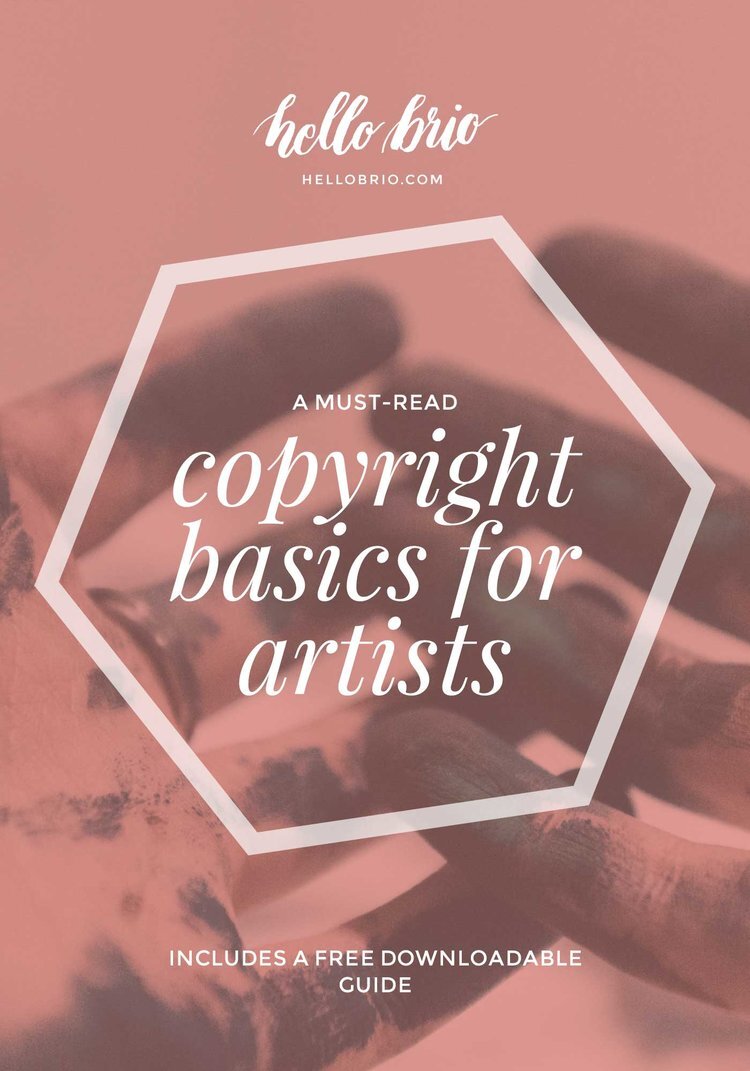Copyright Basics for Artists
It’s important for anyone who creates original work to know the basics of copyright law in the United States (check out your county’s individual laws if you’re from outside of the United States). You’ve taken the time to create something unique and original and you don’t want others to just take your work and profit off of it without your permission, right? Of course not! So let’s learn the about copyright law for creatives now, so we can all keep our work protected.
So What Are the Basics of Copyrights?
Copyrights are the legal system that give creators of literary and creative works the right to control copying of their work. As an artist, this means that you have the sole rights to:
Make copies of your work
Create derivative versions of your work,
Sell copies of your work and
Display the work publicly.
Other people can only get these same rights if they have your permission or have received rights from you somehow, such as if they bought the copyright to your work.
How Do I Copyright My Artwork?
In the United States, you don’t actually need to do anything to copyright your work. Anything that you create is copyright protected the second that it is created. Therefore, if you made a digital print on your laptop, you own the copyright to this work as soon as you create it, not just when you publish it to your website or store. Since copyright exists automatically, this means that you don’t need to go out to register your work in order to have copyright protection.
However, you will have greater protection with a registered copyright. This puts your right on public record and gives you an official certificate of registration. In order to sue for copyright infringement, your work must have been registered formally before the infringement occurred. Also if you sue and win, you will have more available remedies available.
Before we delve more into those remedies, let’s first discuss how you can protect your art or designs and whether you should do it.
Should I Formally Copyright My Work?
Even though your work is automatically copyright protected once it’s created, I just mentioned how you have greater protection and remedies with a formal copyright. But before we talk about those extra protections, let’s discuss whether you really need to register your work.
There are a few things to consider when thinking about copyrighting your artwork, since a formal copyright isn’t necessary for everyone. Let’s think about the work that is most likely to be stolen and used without permission. This is usually work that has the most mass market appeal, such as work that can easily be recreated and used on t-shirts, posters, coffee mugs, etc.
If you work is more conceptual, abstract or difficult to reproduce, you are at less risk for having your work copied or reproduced without your permission (even though this isn’t necessarily impossible). If you feel like your work is more prone to being stolen and used by others for a profit, it might be a better idea for you to formally copyright your art. (See below for more info on how to actually do this.) You can consult with a local attorney who specializes in this area if you want more insight.
What Happens If Someone Uses My Work Without My Permission?
Now let’s get back to to what happens if someone does actually steal and profit from your work. If this happens, in order to file a lawsuit for copyright infringement, your work must be formally registered with the Copyright Office. So if your work wasn’t registered, you’d have to go ahead and register it before filing your lawsuit. So if you think there’s a good chance of your work being infringed, it might be a good idea to file for your copyright once your work is created, instead of waiting until you need to sue someone.
Additionally, if your work was registered prior to the infringement and you win in a lawsuit, you can get additional damages, including an award of attorney’s fees plus other incidental costs of litigation (such as filing fees, copying fees, etc). If your art wasn’t registered prior to the infringement, you can’t get these extra damages.
Another benefit to having your work copyrighted is that you are able to get “statutory” damages, which are punitive damages to “punish” the infringer. These damages can be up to $150,000 per work infringed if the court decides that it was willful infringement (meaning it was on purpose). That can be a lot compared to your maximum remedy if your work wasn’t registered prior to the infringement, which is an amount limited to the infringer’s actual profits they earned from using your work (which is whatever money they made minus their own costs and expenses).
Ok, I know this can be confusing, so let’s break this down really quick. Let’s say a company used one of your images on a coffee mug. The infringer sold 100 mugs with a profit of $5 per mug, for a total profit of $500. If your artwork wasn’t registered prior to this infringement, you’d need to first go out and register your work (since it needs to be registered before you can sue) and then your damages would be capped at $500. That’s it. But, if your artwork was already registered at the time of the infringement, you could also get those “statutory” damages of up to $150,000 per work (if it was willful infringement), plus attorney’s fees and other costs. This doesn’t mean you will actually get that much money, but it is an example to show that you have much greater remedies if your work was already registered.
This is all about weighing the costs and benefits. As I mentioned above, not everyone is likely to have their work infringed, so you really need to weigh everything out for your individual situation. If your work is really popular and you can see it easily being mass marketed, it may be worthwhile to look into registering for copyrights.
Ok, So How Do I Register My Copyright?
Registering your copyright requires three things: (1) your completed application form, (2) a non-refundable filing fee and (3) a non-returnable deposit (which is a copy or copies of your work to be “deposited” with the Copyright Office). You can apply either online (through the electronic Copyright Office, or eCO) or using paper forms (access the forms through the Copyright Office website). Both of those links will provide you with more information on registering your copyright, including the timelines and fees involved. Registering online is often faster and cheaper, but there are some circumstances where you might want to register through the paper forms.
Do I Need to Include a Copyright Notice?
Officially, no you don’t. Before 1989, a copyright notice or statement was mandatory on all published works, but now the notice is optional. You don’t need to have a registered copyright in order to include the notice on your work and use of a notice does not require permission from the Copyright Office. Even though you don’t officially need the notice to establish your copyright, it’s a good idea to include a notice anyways, whether or not you officially registered your copyright. Why?
Your copyright notice lets others know: (1) your work is protected by copyright, (2) the copyright owner and (3) the year of first publication. Thereafter if your work is ever infringed and your work has the notice included, this will make your case stronger and the infringer won’t be able to argue that she didn’t know the work was copyrighted.
You should place this notice on all of your individual pieces. You can include it on the front of the work or, if this would look ugly, you can include this on the back instead. You can also include a watermark with the copyright symbol on any of your works of art online so that no one can easily steal and copy them. If you are a blogger or have a website, you should also include the notice on your website.
It doesn’t need to be anything huge and can be as simple as this example: © 2015 Jane Doe. It’s a good idea to include this anytime you share your work, since it puts others on notice that you are the owner of the copyright. Then if there is ever an issue, the infringer can’t argue he or she didn’t know it was copyrighted work, since your copyright notice is right on there!
Ok, I hope that you stuck with me until the end. I know copyright law can be confusing and not super fun. It’s all about putting the safeguards in place now so you don’t have to deal with headaches in the future. If you have specific questions are copyrights, you can email me. I can’t give specific legal advice, but I can try to point you in the right direction.
I know this is a lot to remember, so I’ve created a great quick guide you can refer back to anytime—download the free resource guide on copyright basics for artists!
Disclaimer: I am an attorney, but I am not your attorney. The information in this article is for general informational purposes only and is not legal advice. This article does not create an attorney-client relationship. The author is not liable for any losses or damages related to actions of failure to act related to the content in this article. If you need specific legal advice, consult with an attorney who specializes in your subject matter and jurisdiction.
Cover photo via Amaury Salas











